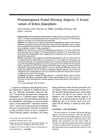TLDR Accurate diagnosis and aggressive treatment are crucial to prevent permanent hair loss in cicatricial alopecia.
The study reviewed 112 cases of primary cicatricial alopecias over 5 years at the University of British Columbia Hair Clinic, representing 3.2% of consultations. It found a 4:1 ratio of lymphocytic to neutrophilic cicatricial alopecias, with lymphocytic types more common in middle-aged women and neutrophilic types in middle-aged men. Accurate diagnosis required careful clinicopathologic evaluation, often necessitating multiple scalp biopsies due to the variable clinical course. The study emphasized the need for aggressive, multi-modal treatment to prevent irreversible follicular destruction, suggesting cicatricial alopecia should be treated as a trichologic emergency. Treatment options included corticosteroids, antimalarials, and isotretinoin for lymphocytic types, and antibiotics, corticosteroids, and isotretinoin for neutrophilic types.
 57 citations
,
January 2003 in “Clinical and experimental dermatology”
57 citations
,
January 2003 in “Clinical and experimental dermatology” Postmenopausal frontal fibrosing alopecia is a type of hair loss in postmenopausal women that may stop on its own but has no effective treatment.
24 citations
,
May 2000 in “Journal of the American Academy of Dermatology” Pseudopelade can affect both the scalp and beard, causing hair loss.
2 citations
,
November 1999 in “Journal of Cutaneous Medicine and Surgery” 226 citations
,
February 1999 in “British Journal of Dermatology” Folliculitis decalvans and tufted folliculitis are related, and a new treatment with rifampicin and clindamycin is effective.
 329 citations
,
January 1997 in “Journal of the American Academy of Dermatology”
329 citations
,
January 1997 in “Journal of the American Academy of Dermatology” Frontal fibrosing alopecia is a hair loss condition in postmenopausal women, similar to lichen planopilaris, with ineffective treatments.
78 citations
,
June 1989 in “The Journal of dermatologic surgery and oncology” Acne keloidalis is a chronic skin condition on the back of the neck in young black men, needing surgery for severe cases.
32 citations
,
August 1982 in “Journal of the American Academy of Dermatology” GLPLS and LPP are variants of lichen planus.
 4 citations
,
July 2015 in “Case Reports in Dermatology”
4 citations
,
July 2015 in “Case Reports in Dermatology” A woman with unexplained hair loss was found to have harmless skin tumors and a scarring hair loss condition, but the tumors didn't cause the hair loss.



